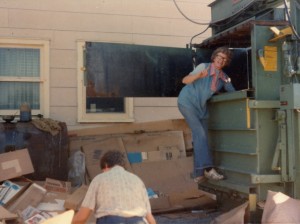Reduce, reuse, revolutionize
Features — By Laura Taubman“[We] felt like throwing a party when we threw the first jug in,” Zantow says.
E-Z Recycling was one of the first centers in the U.S. — if not the only center — to recycle plastic, newspaper, cardboard, glass, aluminum and tin.
Initially, the plastic recycling program only included milk jugs. With the help of local markets and community centers, Zantow and Ehl established drop-off locations where people could leave old milk containers. They told their families and friends, and soon milk jugs piled up.
“They began getting so full, so we knew people were as worried as we were,” Zantow says. “But they didn’t know what to do about it.”
A recycling revolution is born
As E-Z Recycling grew, Zantow was determined to expand the program to include detergent bottles, shampoo bottles and other types of plastic. Once again, plastics experts discouraged her, saying her project would be too labor-intensive given the variety of plastics involved. Zantow refused to give up.

Milly Zantow at work recycling. Photo by Milly Zantow
“They’re just a different type… of plastic, and they’re recyclable,” Zantow recalls telling a group of legislators that laughed at her idea. Undeterred, she met with the UW-Baraboo science department to learn how to distinguish different types of plastic-using burn tests, smoke tests and water weight tests.
“I don’t think until I got mixed up in [recycling]… that any [companies] were recycling plastic,” Zantow recalls in “Plastics One Through Seven,” a 2009 documentary by Liese Dart.
Soon Zantow received calls from companies around the country, wanting to know if certain types of plastic were recyclable. “That’s how I kept going,” she says.
Reinventing recycling
As the recycling movement caught on, Zantow realized people needed a system to distinguish different types of plastic.
“We came up with the idea of a little imprint on the bottom of every container, a little triangle emblem, with a number inserted in it,” Zantow says in “Plastics One Through Seven.”
The Society of the Plastics Industry standardized the now-iconic triangle codes in 1988. Today they’re used around the world to separate plastics.
Mitman says the symbols “helped transform the way we think about and practice recycling in the U.S.”
Shortly after recycling codes were standardized, Zantow celebrated another victory: Wisconsin passed a recycling law in 1989, requiring paper, metal, glass and plastic be collected and kept out of landfills. The legislation came after years of lobbying by Zantow and other recycling activists. Zantow’s years of advocacy did not bring her fame or fortune. Outside the environmental movement, her name is virtually unknown. But those familiar with her story insist that she is a role model, not just for environmental advocates, but for anyone seeking to incite change.
“I think what we learn is that it’s really true that one person can make a difference,” Mitman says. “This is somebody that had a real passion and commitment, and persevered and as a result helped changed the world.”
Click the image below to watch this interactive timeline of Milly Zantow’s recycling revolution.
Tags: Recycling, Taubman





 Digg This
Digg This Bookmark
Bookmark Stumble
Stumble